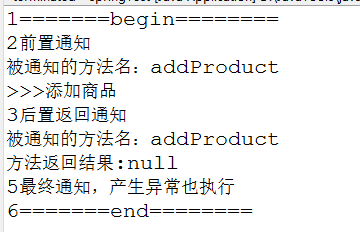06 Spring AOP
1、AOP概念
AOP就是面向切面编程,在原有方法的前边或者后边增加一些业务逻辑代码。
相关术语:
1、连接点:程序执行过程中的某个时间点。
2、切入点:就是需要切面编程的连接点。
3、通知:是在切入点前边或者后边要执行的一段代码,通知有分为:前置通知,后置通知,异常通知,最终通知和环绕通知等。
4、切面:指封装切入点和通知的一个类。
5、目标对象:被增强的对象。
2、通知类型说明
1、前置通知:在目标方法执行前实施增强。
2、后置返回通知:在目标方法执行后执行,如果产生了异常,则不会被执行。
3、后置最终通知:在目标方法执行后执行,有异常,也会被执行的通知。
4、异常通知:当目标方法执行过程中产生异常,则执行的通知。
5、环绕通知:在目标方法执行前和目标方法执行后执行的通知。
6、引入通知:在目标类中增加一些新的方法和属性,用来对目标类进行扩展。
3、AspectJ切入表表达式
基本语法:
@Pointcut(value="execution(modifiers-pattern? ret-type-pattern declaring-type-pattern.methodName-pattern(param-pattern) throws-pattern?)")
1)末尾有?的代表可以省略。
2)modifiers-pattern? 目标方法的修饰符匹配符,如public , private
3)ret-type-pattern 目标方法返回值匹配符,如void、string等,* 代表所有类型。
4)declaring-type-pattern 目标方法类路径匹配符,如cn.sjxy.service.UserService,*代表所有类型
5)methodName-pattern 目标方法名称匹配符,例如Insert,Update,*代表所有方法名。
6)param-pattern 目标方法参数匹配符,(..)代表所有的参数,包含无参方法。
7)throws-pattern? 目标方法抛出的异常类型
例如:
//定义切入点,设定切入点表达式,方法名是切入点名称 @Pointcut(value="execution(* cn.sjxy.Service.ProductService.*(..))") @Pointcut(value="execution(* cn.sjxy.Service.ProductService.addProduct(..))")
4、AspectJ框架的使用 - 注解
1、pom.xml引入依赖包
<project xmlns="http://maven.apache.org/POM/4.0.0" xmlns:xsi="http://www.w3.org/2001/XMLSchema-instance" xsi:schemaLocation="http://maven.apache.org/POM/4.0.0 https://maven.apache.org/xsd/maven-4.0.0.xsd">
<modelVersion>4.0.0</modelVersion>
<groupId>cn.sjxy</groupId>
<artifactId>chapter02Maven</artifactId>
<version>0.0.1-SNAPSHOT</version>
<dependencies>
<!-- https://mvnrepository.com/artifact/org.springframework/spring-context -->
<dependency>
<groupId>org.springframework</groupId>
<artifactId>spring-context</artifactId>
<version>5.3.0</version>
</dependency>
<!-- https://mvnrepository.com/artifact/org.springframework/spring-aop -->
<dependency>
<groupId>org.springframework</groupId>
<artifactId>spring-aop</artifactId>
<version>5.3.0</version>
</dependency>
<!-- https://mvnrepository.com/artifact/org.springframework/spring-aspects -->
<dependency>
<groupId>org.springframework</groupId>
<artifactId>spring-aspects</artifactId>
<version>5.3.0</version>
</dependency>
</dependencies>
</project>
2、applicationContext.xml 开启AspectJ注解使用方式
<?xml version="1.0" encoding="UTF-8"?>
<beans xmlns="http://www.springframework.org/schema/beans"
xmlns:xsi="http://www.w3.org/2001/XMLSchema-instance"
xmlns:context="http://www.springframework.org/schema/context"
xmlns:aop="http://www.springframework.org/schema/aop"
xsi:schemaLocation="http://www.springframework.org/schema/beans
http://www.springframework.org/schema/beans/spring-beans-2.5.xsd
http://www.springframework.org/schema/context
http://www.springframework.org/schema/context/spring-context-2.5.xsd
http://www.springframework.org/schema/aop
http://www.springframework.org/schema/aop/spring-aop-3.1.xsd">
<!-- 开启扫包 -->
<context:component-scan base-package="cn.sjxy"/>
<!-- 开启AspectJ 注解 -->
<aop:aspectj-autoproxy />
</beans>
3、业务类代码
package cn.sjxy.Service;
import org.springframework.stereotype.Service;
@Service(value = "productService")
public class ProductService {
public void addProduct() {
System.out.println(">>>添加商品");
int a=1,b=0,c;
c=a/b;
}
public String findProduct()
{
System.out.println(">>>查看商品");
return "SSM框架";
}
public void modifyProduct()
{
System.out.println(">>>修改商品");
}
public void deleteProduct()
{
System.out.println(">>>删除商品");
}
}
4、切面类代码
package cn.sjxy.Aspect;
import org.aspectj.lang.JoinPoint;
import org.aspectj.lang.ProceedingJoinPoint;
import org.aspectj.lang.annotation.After;
import org.aspectj.lang.annotation.AfterReturning;
import org.aspectj.lang.annotation.AfterThrowing;
import org.aspectj.lang.annotation.Around;
import org.aspectj.lang.annotation.Aspect;
import org.aspectj.lang.annotation.Before;
import org.aspectj.lang.annotation.Pointcut;
import org.springframework.stereotype.Component;
@Component
@Aspect
public class MyAnnotationAspect {
//定义切入点,设定切入点表达式,方法名是切入点名称
@Pointcut(value="execution(* cn.sjxy.Service.ProductService.addProduct(..))")
private void myPointCut() {}
//前置通知
@Before(value="myPointCut()")
public void beforeAdvice(JoinPoint jp)
{
System.out.println("2前置通知");
System.out.println("被通知的方法名:"+jp.getSignature().getName());
}
//后置返回通知,能够获取到方法的返回值,有异常,则不执行
@AfterReturning(value="myPointCut()",returning = "obj")
public void afterReturningAdvice(JoinPoint jp,Object obj)
{
System.out.println("3后置返回通知");
System.out.println("被通知的方法名:"+jp.getSignature().getName());
System.out.println("方法返回结果:"+obj);
}
//环绕通知,在方法的前边和后边执行,有异常,则后边不再执行
@Around(value="myPointCut()")
public Object roundAdvice(ProceedingJoinPoint pjp) throws Throwable{
System.out.println("1=======begin========");
Object resultValue = pjp.proceed();
System.out.println("6=======end========");
return resultValue;
}
//异常通知,产生异常时执行
@AfterThrowing(pointcut="myPointCut()",throwing="ex")
public void exceptionAdvice(Throwable ex)
{
System.out.println("4异常通知:程序的运行异常为:"+ex.getMessage());
}
//最终通知,有异常也执行
@After("myPointCut()")
public void afterAdvice()
{
System.out.println("5最终通知,产生异常也执行");
}
}
5、测试类代码:
public class SpringTest {
public static void main(String[] args)
{
ApplicationContext context = new ClassPathXmlApplicationContext("applicationContext.xml");
ProductService s = (ProductService)context.getBean("productService");
s.addProduct();
}
}
6、执行结果截图 - 无异常

7、执行结果截图 - 有异常

3和6的通知不会被执行到。







 浙公网安备 33010602011771号
浙公网安备 33010602011771号